
| WWT Shows | CLICK TO: Join and Support Internet Horology Club 185™ | IHC185™ Forums |

|
• Check Out Our... • • TWO Book Offer! • |
Welcome Aboard IHC185™  Internet Horology Club 185
Internet Horology Club 185  IHC185™ Discussion Site Main Page
IHC185™ Discussion Site Main Page  Horological Discussions, Questions and Answers
Horological Discussions, Questions and Answers  Pocket Watch Discussions
Pocket Watch Discussions  Waltham Premiere Colonial
Waltham Premiere Colonial
 Internet Horology Club 185
Internet Horology Club 185  IHC185™ Discussion Site Main Page
IHC185™ Discussion Site Main Page  Horological Discussions, Questions and Answers
Horological Discussions, Questions and Answers  Pocket Watch Discussions
Pocket Watch Discussions  Waltham Premiere Colonial
Waltham Premiere ColonialGo  | New Topic  | Find-Or-Search  | Notify  | Tools  | Reply to Post  |  |
Hi! I have come to another black hole in my knowledge about pocket watches,....and there is sure more to come. I do not find any similar in any of my referens books, so please help. What size, common or rare? Any other useful info? I do not have any picture at the mvt yet. Hope to get one but I´m not sure. Best wishes! Bernhard | |||
|
The dial Bernhard Schmidt 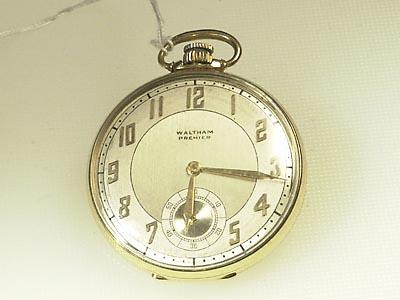 | ||||
|
Waltham must have played fast and loose with the word "Premier", since it appears on this nice 21-j and also on a low-end 9-j wrist watch I have. | ||||
|
| IHC President Life Member |
That's a beauty Bernhard, Can you show us the movement? Lindell | |||
|
Bernie, To answer your question about 3/0 size watches: they're 1 3/30" or 1.100", 27.94mm, or 12 3/8 lignes (12 lignes being 1.066" or 27.07mm) If you look on page 34 of the 2003 shugart, you'll see a full discussion of watches sizes. Hope that helps. (You should recheck before relying on me, because I notoriously can't read charts--but it's certainly about right.) Jessica | ||||
|
| IHC President Life Member |
Thanks Jessica, I doubt it's a 3/0 which is why I'd like to see the movement. Looks like a 12-size or thereabouts to me. Waltham Colonial models came in both 10 and 12-size according to pages 130-133 of Shugart's 2004 Edition. Lindell | |||
|
Ok, here is the mvt, the best picture I could get from the seller. 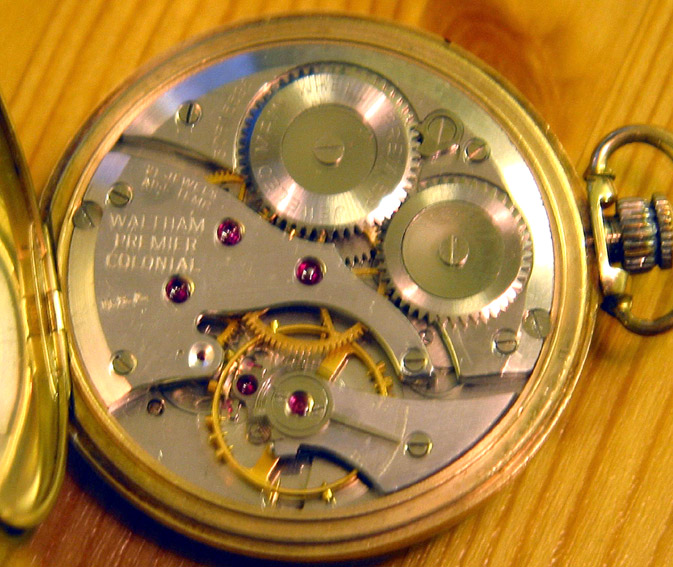 | ||||
|
Thanks Jessica. Lindell you are right (as usual As far as I understand it is a model 1924, 21 jewels and 12 size? It is not listed in "the guide" "Premier Colonial" as far as I can se. The case marks is as follow: Waltham Premier Keystone 14 K gold 6181700 /Thanks Bernhard | ||||
|
Bernhard, Well, It looks like it certainly has the gold center wheel mentioned in the description for material in your watch. It has the jeweling mentioned too. Even though they are not gold the amount of jeweling is correct. (see below) **** You can't argue the NAME, it's right there on the movement. Now, have you tried to measure it? You can use a regular ruler and use the side that says cm. Each one of those little marks in between the numbers 1,2,3 = 1 mm. maybe you can tell by that, what size it is. I use that all the time. The interesting thing is, that they do have movements in the 2004 Cooksey Shugart book, that have different names, and look like yours with only one slight difference, however none of them mention your size watch. Maybe it is unique! Not even listed yet. Maybe not. The Model 1924, the colonial is like yours except one small piece under the regulator. slight diff. everything else is the same. Page 142. No mention of the Gold though so... The 21J is just that, there are 21 Jewels in the watch. The 3/0 is the SIZE. It means that the watch is 1 1/10 inch or 27.94 mm. round. OF means OPEN FACE, there is no cover over the face of the watch just a crystal. It's OPEN. The jewels on yours are not gold though. This is what the Material description says in the glossery for your SN **** "P" stands for "Positions." These are usually 17-23 jewel watches adjusted to 5 or 6 positions. They almost always have a gold center wheel and the highest grades have an entirely gold train. Usually they also have gold jewel settings. The balance wheel usually has gold balance screws, and often has two pair of gold mean-time screws. A "P"-grade balance staff may have two oil grooves and has the finest pivots. The wheel pivots are the finest used on the model. Only the pros can help you with the above information. The size and Jewel info is correct. Good Luck! Sheila | ||||
|
Hi Sheila and thanks! You see, I cant measure it. I do not have it in my hands but the seller says 43.5 mm (the case) witch would NOT make it a 3/0 size mvt, rather a 12 size or am I wrong? | ||||
|
| IHC Life Member RR Watch Expert |
"From information in Roy Ehrhardt's "Encyclopedia Vol. 1" this watch is a 12 size ,Colonial B (which only fits a unique size case). The serial number range was 23,285,001 to 31,934,000. However, Roy does not show a listing for the 21 jewel marked "Premier Colonial. There is a photo of a 17 jewel marked "Premier Colonial ", and a 21 jewel "Riverside" with the "Jeweled Main Barrel" shown on p. 70, that are almost identical to Bernhard's watch. These watches, unlike the earier Colonial series, used only friction jewels w/o settings and had a unique shaped train bridge. These movements used brass (not gold) train wheels and were not marked adjusted. They are of late 1940's vintage. Ed Ueberall IHC Member 34 The Escapement | |||
|
| IHC President Life Member |
Thanks a million Ed, That helps clears it up. Evidently as we often find, the manufacturer blocked the serial numbers for one thing and built something else in its place. Cool watch Bernhard, Lindell | |||
|
Lindell, What do you mean, blocked the serial number? and built something else? Sheila | ||||
|
In MY copy of the Waltham serial number list this movement (30,615,596) is shown as a 1924 Colonial grade no.221, made in 1940-41. This model of movement is also known as the Colonial B, and is 12-size, but thinner than the old (1894 model) 12-size. However, this movement also bears many similarities to the Colonial R (1945 model), such as the monometallic balance and the beveled edge on the movement, and may have been part of a progression towards this later movement. Waltham quality was definitely in a downhill trend by this time, and the company shamelessly used the "Premier" name to try to dress up some otherwise lackluster watches. Bernhard, note that this watch has a replacement crown and bow. (By the way, you cannot count on Shugart to list all of the variants made by most of the companies). | ||||
|
| IHC Member 155 Bulova Watchmaker |
Here is another example of Waltham Colonial. This one is a Maximus A 21 jewel with Diamond end stones From the out side it is a real sleeper but once opened up a high-grade movement in a 14K white gold case. Rich Kuhn IHC Member 155 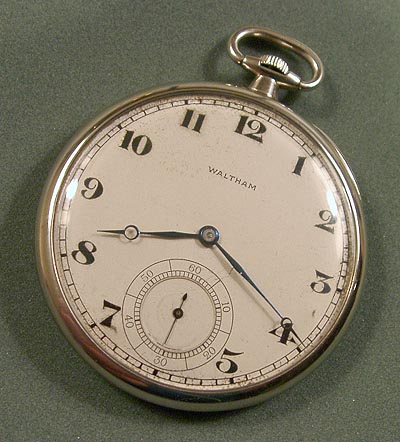 | |||
|
| IHC Member 155 Bulova Watchmaker |
Picture 2 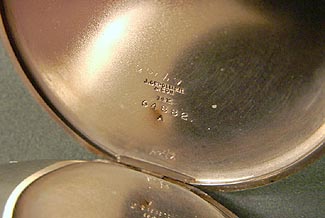 | |||
|
| IHC Member 155 Bulova Watchmaker |
Picture 3 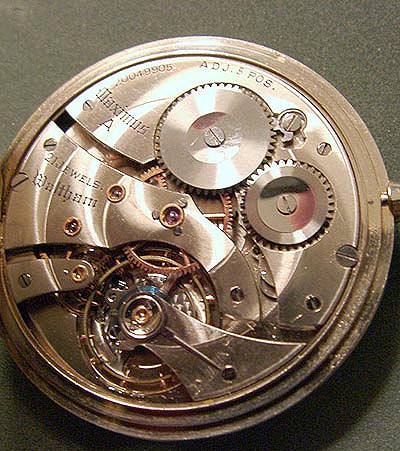 | |||
|
A beautiful watch, Rich. This is the Colonial A model, available first in 14-size (like yours) and a little later in 10-size. These were made only in Maximus or Riverside grades and are consistently high-quality watches. However, in the mid-20s the Colonial B began to supercede this model. At first the Colonial B was a quality watch, with a 21-jewel Riverside grade being the best in this model (and lower grades down to a 17j model), but eventually the finish deteriorated to the example earlier in this thread. Even the Colonial A suffered a decline in finish. I have an early 10-size Maximus A with diamond cap jewels and a full gold train, and another from the last run that only has a gold center wheel and no diamond caps. | ||||
|
Can anyone comment on the regulator, which even on the Maximus appears to be a lower quality type of regulator. I, at least, got the idea that higher grade watches always (or pretty much always) had more complex regulators, with pins etc to control finer changes. Is this part of the downward trend? If so, what would you say the high-point years for Waltham? Is this high point generally shared by the Big Three (Elgin, Waltham, Hamilton), or is there a difference? Jessica | ||||
|
The regulator on Rich's Maximus A is actually quite highly finished, with a rounded and polished index and chamfered edges (if you could see it in person) on the part where the regulator pins are. I suspect that Waltham did not try to use a micrometric regulator on this model because of the emphasis on thinness. They eventually did use one on the Colonial B, but that movement is not as thin as the Colonial A. The Colonial A movement came out around 1912-14 at which time no other American company had a comparably thin movement. In the late 'teens Illinois produced a competing thin movement, and it also did not have a micrometric regulator. The Elgin Hulburd, introduced around 1921, was the first very thin American movement to have a micrometer regulator. Hulburd The flat regulator and no micrometer on the "Premier" (years after lesser Colonial B models DID have a micrometer) are further evidence of the decline at this point. | ||||
|
Thanks, Jerry, that's fascinating. Would you say it was in the twenties or more during WWI that the need for miniaturization renewed itself and the competition for thinness was underway? Or was it earlier? I have some idea that wristwatches had already been available? Or was that WWII? Was there some idea about a gradual switch to wristwatches, or was this done only under pressure from the Swiss? I should be able to look that up in one of my books. I noticed in the earlier thread, that Steve (Dog) was asking about pressed jewels, which it was his understanding were characteristic of lower grade watches. I had this impression at one point also, but someone had disputed this, so I remain unsure. Jessica | ||||
|
In their literature, Waltham claims to have produced the first American-made wristwatch in 1912, noting that these had already been the fashion in Europe for a while. They commented that wristwatches were previously "ridiculed in America as suitable only for effeminate men and strong-minded women". Their first wristwatch models were ladies watches. Wristwatches for men did not become acceptable fashion in America until after WWI (when soldiers wore them). Waltham continued to miniaturize, producing their 7-1/2 ligne ladies movement in 1921 -- Very Tiny Walthams. The even smaller 4-ligne model 400 came later. The effort to produce a thin watch probably began earlier. Howard (Keystone) advertised their 1908 model 12-size watch as an "Extra-Thin" model, although it was largely a proportional thinness, since the dial side of the movement was 14-size. I expect that the Swiss or French may have had some earlier thin pocketwatches, too. | ||||
|
| Powered by Social Strata |
| Your request is being processed... |
|
©2002-2025 Internet Horology Club 185™ - Lindell V. Riddle President - All Rights Reserved Worldwide

